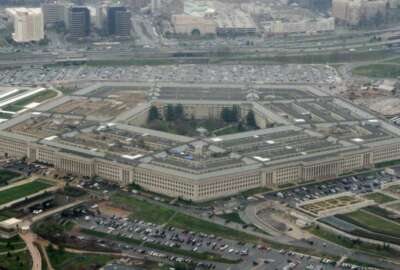
New official will oversee all IT, cyber issues for Navy, Marine Corps
Congress declined to authorize a new assistant secretary of the Navy for information management, so officials are moving on to "Plan B."
Best listening experience is on Chrome, Firefox or Safari. Subscribe to Federal Drive’s daily audio interviews on Apple Podcasts or PodcastOne.
After months of back and forth with Congress, the Department of the Navy has decided on a way forward for how it will restructure its management and governance of information and cybersecurity issues.
Earlier this year, Navy officials had proposed creating a new assistant secretary position to handle what they termed “information management” functions across the Navy and Marine Corps. But Congress was never sold on the idea. So on Friday, Thomas Modly, the undersecretary of the Navy, announced what he said was the next best thing: a special assistant to the Secretary of the Navy who will also serve as the Navy Department’s chief information officer.
Modly said the restructuring was largely prompted by a March review by outside experts which found that the Navy’s poor cybersecurity posture represented an “existential threat” to its warfighting capability.
“The responsibility needs to be elevated to senior levels in the department,” he told reporters. “No one at the senior levels had responsibility for this portfolio — it was very distributed, and so therefore we were finding that we are investing in things without any level of coordination and probably sub-optimizing a lot of our investments. Secondly, the entire concept of cyber hygiene and creating a more cyber conscious culture was missing in the Department of the Navy, and needed to be corrected immediately, which means you needed to elevate this to a much more senior level so that the resources could be aligned towards that.”
The revamped CIO position will fall directly below the Navy secretary and undersecretary in the revised organizational chart. Below that, the special assistant will oversee four new directorates led by four other new senior officials: a chief technology officer, a chief data officer, a chief digital strategy officer, and a chief information security officer.
The Navy declined to identify the person it has hired to fill the special assistant and CIO role, citing formalities in the hiring process. But an industry source said the new leader would be Aaron Weis, who currently serves as a senior advisor to the DoD CIO and who led the development of the Pentagon’s recent cloud computing strategy.
Modly himself has held the title of DON CIO since last March, when he eliminated the CIO as a separate position and delegated some of its authorities to the Navy and Marine Corps. And in some ways, the new special assistant position will resemble the old CIO job. For instance, like before, the office’s top two deputies will be the Marine Corps’ deputy commandant for information and the Navy’s deputy chief of naval operations for information warfare.
But Modly insisted the new DON CIO function was not merely a return to the previous status quo.
“The previous DON CIO billet, from my perspective, was more of a compliance shop and less of a proactive organization developing strategy for the department. So it’s going to be far more strategic than the former DON CIO’s office was,” he said. “We’re also going to be trying to attract private sector talent into this, and we’ve got some authorities that we can use not just for hiring, but also for compensation. Congress gave us five billets where we can pay up to one and a half times the salary of the vice president, so that gets us up into the low-$300,000 range for some of these people.”
As one example of the ways in which the new office will play a larger role in strategy across the two sea services, Modly pointed to the new digital strategy officer the Navy hopes to recruit in the coming months.
“Right now, if you look at our supply chain and logistics chain, it’s our biggest weakness with respect to auditability and data clarity. And that’s because no one owns it,” he said. “We have a lot of data in the department, but it’s not structured in a way that makes it useful so that we can get meaningful information out of it. So the chief data officer and the chief digital officer are going to work very, very closely together to ensure that the department has data that’s usable. And then once it’s usable, how do you actually use it?”
Although it may use its new authorities to offer larger-than-usual government salaries to some of the IT executives it hopes to recruit, the Navy has assured Congress that it doesn’t intend to create a large new bureaucracy within the Navy Secretariat, Modly said. Most of the positions that will staff the new CIO organization will come from internal restructuring.
But many of the details about how the new special assistant will operate are yet to be determined. Modly said the new leader’s first job would be to get a clear understanding of the authorities the department already has and how to leverage them.
“We’re going to have to change SECNAV instructions to ensure that the authorities are aligned and who’s going to be responsible for what,” he said. “Developing an organization that has clear lines of authority is probably going to be the very first thing that they do to establish the credibility and authority of this particular organization.”
Copyright © 2025 Federal News Network. All rights reserved. This website is not intended for users located within the European Economic Area.
Jared Serbu is deputy editor of Federal News Network and reports on the Defense Department’s contracting, legislative, workforce and IT issues.
Follow @jserbuWFED







